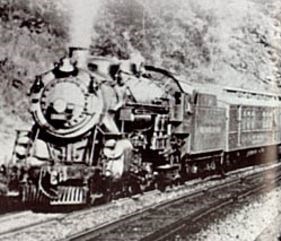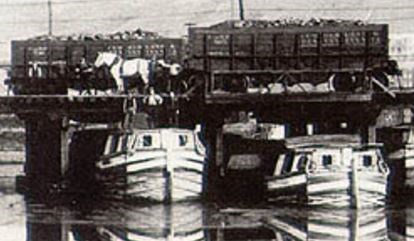
NPS Photo The joyful crowd gathered early on October 10, 1850, as the Independent Blues Band played. Folks came from far and near to celebrate the long awaited opening of the Chesapeake and Ohio Canal between Cumberland and tidewater Maryland. A procession of citizens and officials marched to the locks at the mouth of Wills Creek where five coal boats waited to start the run down to Georgetown. "Many of us were young when this great work was commenced," said the spokesman for the town, "The opening of yonder gates to let through the first boat carrying freight...is the turning point in the history of the canal." An Engineering MarvelTo reach Cumberland, canal engineers began near the nation's capital in 1828 to construct 184.5 miles of ditch and towpath. They built 74 locks, 7 dams, 11 aqueducts and a 3,118-foot tunnel--remarkable achievements with the tools of the day. As each dam was completed, diverting water from the Potomac River into the canal, boats began using the watered sections. The canal arrived opposite Harpers Ferry, Virginia (later West Virginia), in 1833 and reached Hancock, Maryland, in 1839. Work on the final 50 miles was stalled by labor unrest, financial troubles and the challenges constructing the tunnel at Paw Paw. Meanwhile, the nation's first railroad, the Baltimore & Ohio, steamed into Cumberland in 1842. The railroad, which had begun its East-West route the same day as the canal won the race to Cumberland. Passengers could continue the trip from Baltimore to the Ohio Valley by boarding a horse-drawn stagecoach at Cumberland and crossing the mountains on the National Road. The railroad eventually continued westward but the canal company abandoned plans to build the waterway farther than Cumberland. 
NPS Photo Waterway Pays OffDespite the brave oratory of opening day, canal business grew slowly, delayed by seasonal floods, then threats to commerce during the Civil War. In the 1870's, the canal at last made good its bright promise. The rich harvest of coal from western Allegany County mines became the mainstay of canal shipping. A small world of canal enterprise developed in Cumberland around the two boat basins--stables, drydocks, hotels, saloons and warehouses. Branch rail lines entered the area to facilitate loading of coal. In 1870 canal boats moved almost a million tons of freight, not only coal but building materials, lumber, and flour from local mills. From Port to PortOffers of land persuaded canal company officials to locate Dam 8 and the turning basins for boats at Cumberland's commercial center. The canal terminus settled on a part of town known as "Walnut Bottom." Just below Dam 8 two basins were dug, the main basin stretching in a long curve next to the North Branch of the Potomac River. Beyond that lay the broader Shriver Basin. The double locks watered both basins, although a steam pumping station was needed later to boost the water level for the 50 miles of canal downstream. Stores for provisions crowded grog shops and pool parlors--among them such colorful bars as Aunt Susan's Rising Sun Saloon and Louise's Den of Iniquity. The string of establishments along Wineow Street that served the watermen was called "Shantytown." "Probably the roughest, toughest spot along the Canal," according to one mule driver. The company's boatyard was located about where the railroad station now stands. Frederick Mertens operated another boatyard near the entrance to Shriver Basin. At that point a trestle carried coal company railroad cars above boats lined up to receive coal by chute. New wharfs and warehouses bordered the area. At the canal's peak, as many as 500 boats a season plied the canal and waited turns in the basins to collect cargo. One tall tale speaks of a bulldog trained to swim the towline across the basin so as to speed hitching up the mules. The port of Cumberland was busy; at its peak, boatyards turned out 170 new craft, repair scows moved to shore up embankments and tandem-hitched mules in stepped briskly down the towpath. Many boatmen and families wintered in Cumberland when the canal did not operate. During the decades around the turn of the century, the city of Cumberland attracted new industries and enjoyed at robust prosperity. The population doubled and doubled again. A rolling mill for the manufacture of rails set up shop along with tanneries, glassworks and a furniture factory. Footers Dye Works began business on the far side of Shriver Basin. Cumberland ranked as the second largest city in the state, after Baltimore. Golden Years Washed AwayIn 1889 a devastating flood destroyed the canal. For 18 months no boats could move; the canal company went bankrupt. The canal's long time rival, the B&O Railroad, took over receivership under the name Consolidation Coal Company. In return for restoring operations control of the canal passed into the hands of the railroad directors. As the canal's freight business dwindled the receivers sold parts of the basins. Under the Canal Towage Company (another subsidiary of the B&O), organized in 1902 to manage the boats, mules and watermen, the canal folk lost their independent ways of life. Boats once owned by the watermen became company property; impersonal numbers replaced the boat names. The Western Maryland Railroad filled in the upper reach of the main basin and built its station, part of which is now the park's visitor center. Another great flood in 1924 left the canal in ruins. The railroad that had been considered at the start "an experiment wholly untried in any country," ushered in the nation's industrial boom. The canal age was abandoned to history. Since 1971 the canal has a new lease on life as the Chesapeake and Ohio Canal National Historical Park. The national Park Service has restored the towpath and rewatered several sections of the canal. The park offers visitors a rich resource of recreation and preserves a significant landmark of trade and transport in the new nation. |
Last updated: December 15, 2020
